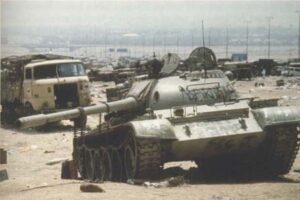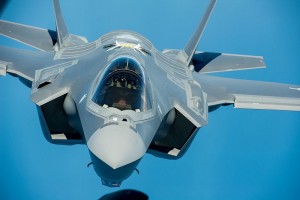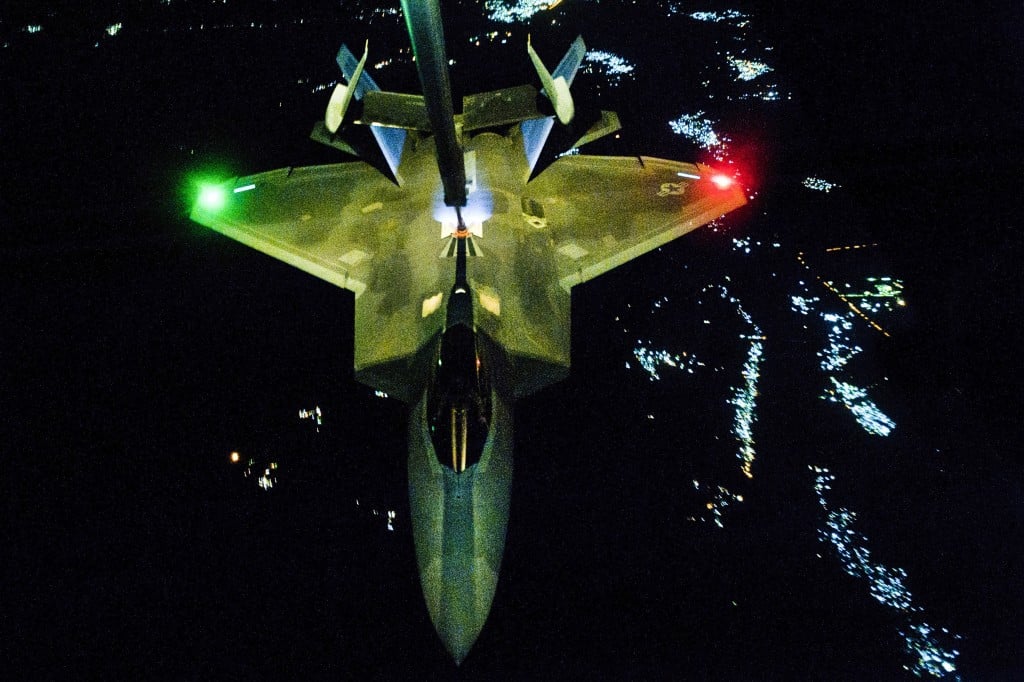
F-35As at Luke Air Force Base
Today’s United States Air Force faces a stark challenge: securing the sky in the face of ever increasing threats. Decades of deferred investment and an increasingly unstable world make this a critical issue facing the new Trump administration. Over 3/4 of the current Air Force fighter fleet is comprised of 1960s and 1970s designs that average well over a quarter of a century old. Too few modern, 5th generation F-22s and F-35s exist to meet the basic demands of the U.S. national security strategy. [Read about the F-22’s impending deployment to Australia]. Sequestration and recent decisions by Congress to limit F-35 procurement in fiscal year 2017 make the issue worse. Bottom line: The nation needs to accelerate its fighter modernization to meet its security demands.

Iraqi vehicles on the “Highway of Death” in 1991
The requirement for accelerated investment is alarmingly clear. No military operation can successfully occur without control of the air. Anyone doubting this conclusion should review pictures from the “highway of death,” where Saddam Hussein’s retreating forces were annihilated from above as they fled Kuwait in 1991. These images stand in stark contrast to American forces rapidly covering the same territory a decade later unimpeded by enemy aerial attack. Potential adversaries around the world have learned this lesson, analyzed our weaknesses, and invested heavily to counter U.S. airpower capabilities with advanced fighters, sophisticated radars, and surface to air missiles.
Having too few modern fighters limits important policy options. For example, if Russia were to launch a major offensive against a NATO ally requiring a US response, all operational F-22s and F-35s would have to be committed to the effort. That is only about 130 deployable combat-coded jets. There would be no spare 5th generation fighters available to deter other adversaries elsewhere. This could embolden China, North Korea, or Iran to take aggressive action. American leaders would have limited options: either respond to the new threat with potentially inadequate forces, or pull much-needed combat power from the first threat to tackle the second. Either option would leave US credibility in shreds, threaten our alliances, and place US global interests at enormous risk. America’s enemies are well aware of this dilemma, and it is encouraging much of the aggressive action we see today from China and Russia.

An F-22 intercepts a Russian Tu-95 Bear.
An important part of the solution to this sobering situation is straightforward: build F-35s at a faster rate, and accelerate Air Force future fighter development.
The case for increasing the F-35 procurement rate is two-fold: proven results and basic economics. To start with, the F-35 not only works, but is enormously more effective than prior generation aircraft. In early operational exercises, out of 32 separate F-35A engagements against F-15Es, the F-35A sustained zero losses. The Marine Corps is getting similar results with their F-35Bs. Operational pilots are finding the F-35 is fundamentally changing the way the U.S. Marine Corps thinks about operating from its sea bases.
F-35 capabilities, especially when it comes to enabling new warfighting concepts like the “combat cloud,” are radically changing how the US and its allies execute missions and project power. These earned achievements stand in stark contrast to the negative stories and stereotypes surrounding the program.
From a business case perspective, acquiring F-35s faster is a prudent economic decision. Legacy fighters like the F-15 and F-16 require expensive structural upgrades and new mission systems the longer they remain in service. Technical and parts obsolescence drive up the cost of such upgrades, as does the fact that many suppliers are no longer in business. Continued investment in 40 year-old designs is questionable, given that many of these aircraft simply cannot survive modern threat air defenses. How cost-effective is it to invest billions of dollars in geriatric fighters that will end up getting shot down by modern air defenses the first day of the next conflict? The only way to get around this challenge is to retire older aircraft sooner in order to buy survivable F-35s faster.

Air Force F-35A
The ever-declining cost per F-35 is now approaching the same unit cost as old fighters, but the F-35 is demonstrating multiple times the combat power: greater air-to-air effectiveness; greater capability to suppress enemy air defenses; greater survivability. These capabilities make the F-35A more lethal and survivable than any legacy aircraft. Even at the current price point, this makes the F-35 an incredible value, and the unit cost is continuing to degrease. Much ink and hot air have been expended addressing the cost of the F-35 program with little discussion of its effectiveness. Intelligent analysis would shift focus from aircraft unit cost to cost per desired effect. Doing so finds that the F-35 delivers immense value.
Additionally, increasing F-35 production reduces the cost per aircraft by taking advantage of mass production efficiencies—something the program was designed to do, but has yet to realize because of budget cuts that were made independent of our national security needs. To achieve greater cost-effectiveness, the Air Force should be funded to increase its present annual F-35A buy from 43 a year in fiscal year 2017 to 60 per year in FY18 and 100 per year in FY20.
Part of the reason we need to get the F-35 in service faster is that the Air Force was never allowed to purchase the military requirement of 381 F-22s. Less than half this number was procured. While the F-35 is a tremendous aircraft, it was not designed to be first and foremost an air superiority fighter like the F-22. Instead, it was meant to complement the F-22 by focusing on the air-to-ground mission, with respectable air-to-air capability.
So it is not surprising that the USAF’s most recent air superiority plan candidly states: “The Air Force’s projected force structure in 2030 is not capable of fighting and winning against the array of potential adversary capabilities.” The Air Force currently has approximately 120 F-22s capable of going to war at a given time. (Some of the total inventory of 187 is dedicated to training, and a portion are cycling through maintenance). But those 120 would not be deployed en masse to a single time and place, because there would be no “bench” of fighters to sustain the deployment over time, let alone maintain a presence in multiple hot spots at the same time. Instead, fighters are always rotated in batches, with one set of aircraft on station, another returning back to base, and others preparing to launch. This means those 120 combat coded F-22s translates to about 40 able to engage at any given time. Spread those 40 across a region like the South China Sea or Europe, and you have major capacity gaps with little ability to backfill losses.
Addressing this gap requires pursuit of a new penetrating aircraft to collaboratively secure the high-end air superiority mission. The Air Force has already begun efforts in this vein through its penetrating counter air plan. Their vectors are sound but require adequate resourcing to ensure tangible results are realized sooner rather than later.

F-22 refuels during attacks on Syria and ISIL
Given the severity of the air superiority shortfall, a serious, objective study should be conducted of the value of initiating a F-22 derivative with the latest sensor, processing, and avionics enhancements, as well as incorporating design features to allow export sales to Japan, the United Kingdom, Australia, and Israel. With time of the essence, this option may be the most cost-effective and timely way to correct the deficiency in Air Force air superiority capability by 2030 with a realistic, low risk option capitalizing on already proven investments.
Failing to accelerate F-35 production and develop follow-on air superiority capabilities will put US national security objectives at extreme risk. This is a point worth considering within the historic context of last week, the 75th anniversary of the attack at Pearl Harbor. America was vulnerable at that time due to years of lackluster military spending. The outcome of the war was dangerously on the brink until 1944, as the US struggled for three years to generate the force necessary to win. Today, circumstances are precariously similar—with some elements of the military actually below the size they were in 1941. Additionally, we will not have the luxury of three years to compensate for 25 years of neglect of the high-end Air Force. The complexity of modern equipment means it takes far longer to procure, equip, and train modern aircraft systems than it did to build B-17 Flying Fortresses and P-51 Mustangs. The budget decisions of today have an enduring effect, shaping options for the Nation’s defense decades into the future.

David Deptula
Global instability suggests America will be challenged by serious threats sooner than we would like to think. But the country is in a precarious position due to the neglect of our high-end air forces over the past 25 years. The combination of F-35, F-22, KC-46 tanker, and the future B-21 bomber provides America with capabilities that nobody else in the world possesses. For President-elect Trump to make America’s Air Force whole again; attain peace through strength; and secure America’s “asymmetric” military advantage as rapidly as possible, he will need to support modernization of our geriatric Air Force sooner rather than later by increasing the F-35 production rate now. It may also be wise for President-elect Trump to consider that the only thing more costly than a first rate Air Force is a second rate Air Force that risks loss in war.
David A. Deptula, a retired Air Force Lt. General, planned the Desert Storm air campaign, orchestrated air operations over Iraq and Afghanistan, and is now dean of the Mitchell Institute for Aerospace Power Studies. He is a member of the Breaking Defense Board of Contributors.
Air Force picks Anduril, General Atomics for next round of CCA work
The two vendors emerged successful from an original pool of five and are expected to carry their drone designs through a prototyping phase that will build and test aircraft.


























